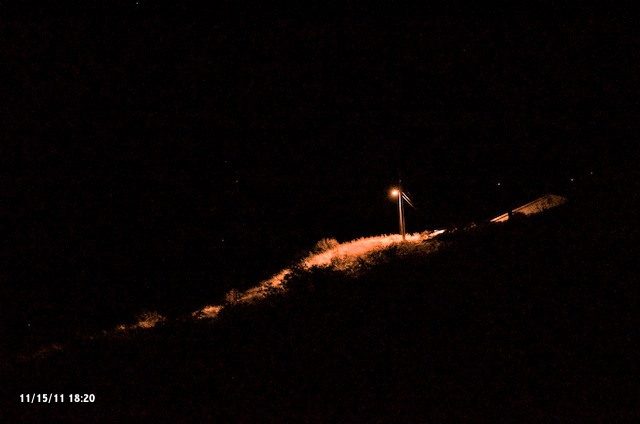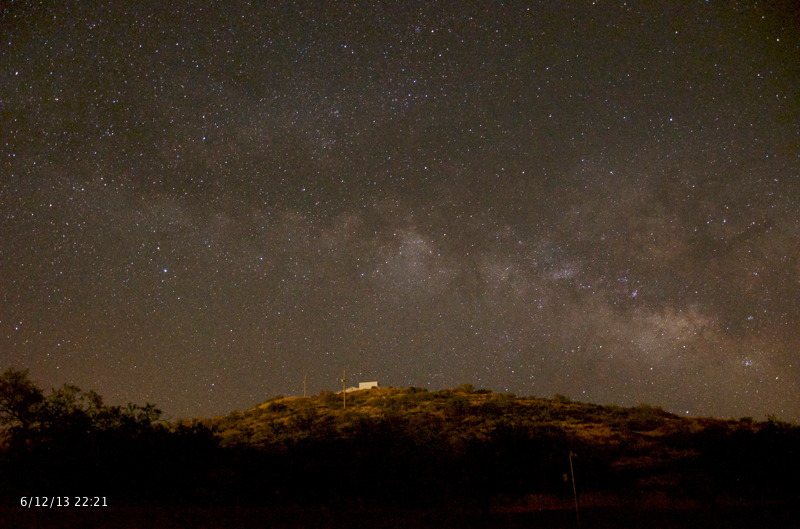
Critters, Crescent Moon, Milky Way, NGC6712 Globular Cluster
Posted: 13 June 2013
 Another pack rat was captured on Tuesday, 11 June 2013. Unfortunately, this one was dead. The count is now 22 live pack rats and 3 dead ones. Another antelope squirrel was also captured, but he died too. Maybe the heat is too much; the daytime temperature has been over 100°F for the last week. The image at the right shows the temperature and humidity at 1333 MST on Wednesday from the Cassiopeia Observatory weather station. I have decided to temporarily halt trapping until the weather cools down.
Another pack rat was captured on Tuesday, 11 June 2013. Unfortunately, this one was dead. The count is now 22 live pack rats and 3 dead ones. Another antelope squirrel was also captured, but he died too. Maybe the heat is too much; the daytime temperature has been over 100°F for the last week. The image at the right shows the temperature and humidity at 1333 MST on Wednesday from the Cassiopeia Observatory weather station. I have decided to temporarily halt trapping until the weather cools down.
Clouds moved in as sunset approached on Tuesday. While checking the final pack rat trap late that afternoon, I saw that two of the baby birds (seen in a photo on the previous report) were no longer in their nest. They couldn't yet fly and momma and poppa birds seemed to be unhappy. I placed the baby birds back in their nest. While dealing with the baby birds, I saw a baby Gila Monster (about 9" long) walking by and I managed to get a photo:

Click (or tap) the image to see a larger version. This is the first Gila Monster I've seen here in Oracle.
The sky began clearing late in the day on Wednesday, 12 June 2013. As I walked to the observatory I saw that all the baby birds were out of their nest again:

The inset shows one of the parents keeping an eye on me.
The observatory was opened at 1908 MST, 104°F. There were clouds in the western sky and the sky was hazy everywhere. At 1916 MST, I took this D7000 DSLR photo of the crescent moon through some thin clouds, f/6.3, 1/640sec, ISO 400, 300mm:

Beginning at 1918 MST, I did some lunar observing through the thin clouds, 83X. I knew this was going to be a short session due to the clouds. I then viewed Venus, followed by Mercury, 83X. I switched to 222X on Mercury, but seeing through the thin clouds was not very good. A slightly less than half-phase was visible however. At 1931 MST, just about sunset, I viewed Saturn, 222X, also through some thin clouds. The planet's shadow on the Ring System appeared to be slightly wider than seen on previous sessions.
Due to the clouds, I closed the observatory at 1941 MST, 93°F.
I checked the sky at 2200 MST and it was clear (but still somewhat hazy). I decided to go to the observatory again this night. The observatory was opened at 2203 MST, 83°F. At 2210 MST, took a quick look at Saturn, 83X. Four moons were visible.
On many recent reports I've commented how nice the sky looks without the private streetlight on the hill to the east being on. This photo, taken in 2011, f/4.5, 1/20sec, ISO 1600, shows the light ON:

I took this photo of the eastern sky at 2221 MST, f/3.5, 15 seconds, ISO 2500, that shows the Milky Way rising over the hill to the east with the hill light OFF:

I could not have captured this nice view had the light been ON. The hillside is illuminated by some other distant light, possibly from the Dollar General Store to the north. But that illumination is very minor compared to how the hillside appeared when the private streetlight was ON in the past. Thanks again neighbor.
At 2224 MST, I resumed Saturn observing. Seeing was not very good, but using 364X the A, B, and C rings were visible. Cassini Division was very distinct during brief momemts of good seeing. The shadows were also good at times. I increased the magnification to 412X, which yielded an OK view, given the poor seeing. 619X was too much with the poor seeing. I took a last look at Saturn at 2246 MST, 83X.
Next, I viewed two DSOs in Lacerta, 83X: NGC7209 and NGC7243, both open star clusters. I then checked Observer Pro on my iPhone for some possible DSOs to observe. I viewed NGC6543 (Cat's Eye Nebula, planetary nebula), NGC6703 (faint galaxy, nice with averted vision), NGC6702 (faint galaxy, Mag. +12.2, just barely visible using averted vision), and NGC6712 (globular cluster). The cluster was made up of faint stars but was still a nice view. I decided to image it.
At 2312 MST, I began setting up to image NGC6712 with the D7000 DSLR at prime focus of the 8" LX200-ACF. I did a focus test image on the star Altair using the Bahtinov Mask. I SYNCed the AutoStar on Altair centered in the camera FOV. I then slewed to NGC6712; it was faintly visible in the D7000 DSLR viewfinder. I then did some 30 and 15 second, ISO 6400, unguided exposures. This is NGC6712 (globular cluster), 15 seconds, ISO 6400, cropped from the full-frame image:

Imaging was completed at 2333 MST. Beginning at 2341 MST, I resumed DSO observing. First was M17 (Swan Nebula), 83X. I then switched to the 2" 9mm 100° eyepiece (222X). The nebula showed some nice details, especially using averted vision. Next was M22 (globular cluster), 222X. Good view. Switched back to the 2" 24mm UWA eyepiece (83X); best view of M22.
Since Scorpius was high in the southern sky now, I viewed some of its DSOs, 83X: M80 (globular cluster), M4 (globular cluster), NGC6124 (open cluster), NGC6231 (open cluster), NGC6302 (Bug Nebula), M6 (Butterfly Cluster, open cluster), and M7 (open cluster).
The last object viewed this night was M20 (Trifid Nebula), 83X. I then began closing for the night.
The observatory was closed at 0030 MST, 78°F.
Comments are welcome; use the Comments section below, or you can Email Me. Thanks.
Cassiopeia Observatory Home Page